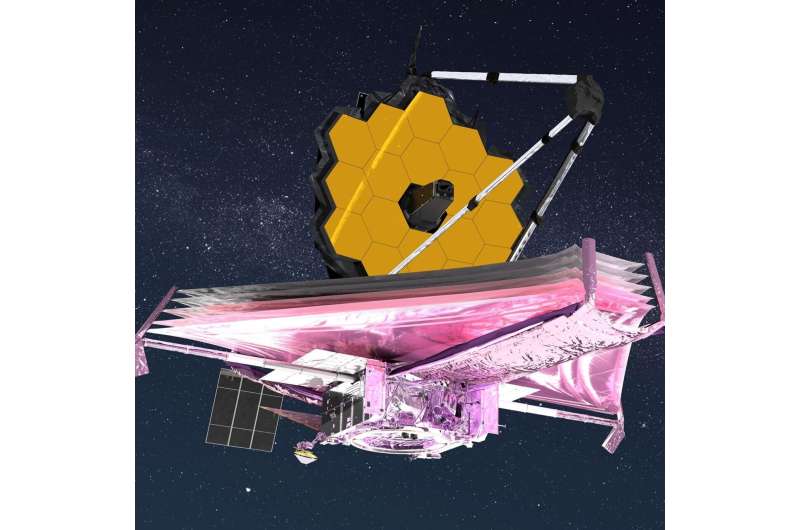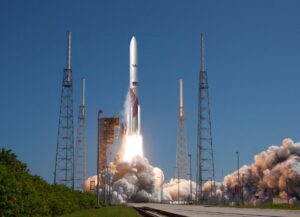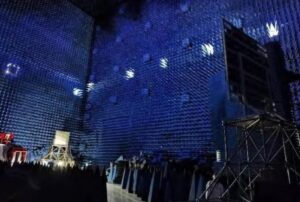NRL CIRCE spacecraft to be part of historic UK launch
Wednesday, 08 June 2022 19:59 A joint U.S. Naval Research Laboratory (NRL)/ U.K. Defence Science and Technology Laboratory (Dstl) experiment is preparing to measure Earth's ionosphere and particle radiation environment as part of the Coordinated Ionospheric Reconstruction CubeSat Experiment (CIRCE) mission.
Space Systems Command is partnering with Virgin Orbit National Systems, a U.S.-incorporated, wholly-owned subsidi
A joint U.S. Naval Research Laboratory (NRL)/ U.K. Defence Science and Technology Laboratory (Dstl) experiment is preparing to measure Earth's ionosphere and particle radiation environment as part of the Coordinated Ionospheric Reconstruction CubeSat Experiment (CIRCE) mission.
Space Systems Command is partnering with Virgin Orbit National Systems, a U.S.-incorporated, wholly-owned subsidi CIRCE space weather suite announced for first UK satellite launch
Wednesday, 08 June 2022 19:59 The Defence Science and Technology Laboratory's (Dstl) miniaturised space weather instrumentation suite will be one of the payloads aboard Virgin Orbit which is targeting the first UK satellite launch this summer from Spaceport Cornwall in Newquay. Virgin Orbit's Launcher One rocket takes off horizontally, carried aloft by a modified Boeing 747 jet, named Cosmic Girl.
The Coordinated Ionos
The Defence Science and Technology Laboratory's (Dstl) miniaturised space weather instrumentation suite will be one of the payloads aboard Virgin Orbit which is targeting the first UK satellite launch this summer from Spaceport Cornwall in Newquay. Virgin Orbit's Launcher One rocket takes off horizontally, carried aloft by a modified Boeing 747 jet, named Cosmic Girl.
The Coordinated Ionos Colossal Collisions Linked to Solar System Science
Wednesday, 08 June 2022 19:59 A new study shows a deep connection between some of the largest, most energetic events in the Universe and much smaller, weaker ones powered by our own Sun.
The results come from a long observation with NASA's Chandra X-ray Observatory of Abell 2146, a pair of colliding galaxy clusters located about 2.8 billion light years from Earth. The new study was led by Helen Russell of the Universit
A new study shows a deep connection between some of the largest, most energetic events in the Universe and much smaller, weaker ones powered by our own Sun.
The results come from a long observation with NASA's Chandra X-ray Observatory of Abell 2146, a pair of colliding galaxy clusters located about 2.8 billion light years from Earth. The new study was led by Helen Russell of the Universit Abell 2146: Colossal Collisions Linked to Solar System Science
Wednesday, 08 June 2022 19:59 A new study shows a deep connection between some of the largest, most energetic events in the Universe and much smaller, weaker ones powered by our own Sun.
The results come from a long observation with NASA's Chandra X-ray Observatory of Abell 2146, a pair of colliding galaxy clusters located about 2.8 billion light years from Earth. The new study was led by Helen Russell of the Universit
A new study shows a deep connection between some of the largest, most energetic events in the Universe and much smaller, weaker ones powered by our own Sun.
The results come from a long observation with NASA's Chandra X-ray Observatory of Abell 2146, a pair of colliding galaxy clusters located about 2.8 billion light years from Earth. The new study was led by Helen Russell of the Universit Detecting new particles around black holes with gravitational waves
Wednesday, 08 June 2022 19:59 Clouds of ultralight particles can form around rotating black holes. A team of physicists from the University of Amsterdam and Harvard University now show that these clouds would leave a characteristic imprint on the gravitational waves emitted by binary black holes.
Black holes are generally thought to swallow all forms of matter and energy surrounding them. It has long been known, howeve
Clouds of ultralight particles can form around rotating black holes. A team of physicists from the University of Amsterdam and Harvard University now show that these clouds would leave a characteristic imprint on the gravitational waves emitted by binary black holes.
Black holes are generally thought to swallow all forms of matter and energy surrounding them. It has long been known, howeve The end of the cosmic dawn
Wednesday, 08 June 2022 19:59 A group of astronomers led by Sarah Bosman from the Max Planck Institute for Astronomy have robustly timed the end of the epoch of reionisation of the neutral hydrogen gas to about 1.1 billion years after the Big Bang. Reionisation began when the first generation of stars formed after the cosmic "dark ages", a long period when neutral gas alone filled the Universe without any sources of light. T
A group of astronomers led by Sarah Bosman from the Max Planck Institute for Astronomy have robustly timed the end of the epoch of reionisation of the neutral hydrogen gas to about 1.1 billion years after the Big Bang. Reionisation began when the first generation of stars formed after the cosmic "dark ages", a long period when neutral gas alone filled the Universe without any sources of light. T Lynred launches two multispectral linear array infrared detectors for EO missions
Wednesday, 08 June 2022 19:59 Lynred, a leading global provider of high-quality infrared (IR) detectors for the aerospace, defense and commercial markets, today announces the launch of two multispectral linear array IR detectors for application in a range of Earth observation missions. Pega and Capyork are designed for integration into imaging satellites, tracking and measurement instruments used in water cycle observation a
Lynred, a leading global provider of high-quality infrared (IR) detectors for the aerospace, defense and commercial markets, today announces the launch of two multispectral linear array IR detectors for application in a range of Earth observation missions. Pega and Capyork are designed for integration into imaging satellites, tracking and measurement instruments used in water cycle observation a Maritime Satcom Connectivity on the Uptick in Nordic Region
Wednesday, 08 June 2022 19:59 The small island of Donso is renowned as a historic fishing village, where even today boathouses at the harbour honour its rich maritime heritage with name plaques of fishing vessels. It forms the perfect backdrop for Sweden's biggest all-inclusive trade fair - Donso Shipping Meet, taking place on June 14th and 15th this year. In the lead up to this event, IEC Telecom Norway, one of the leading
The small island of Donso is renowned as a historic fishing village, where even today boathouses at the harbour honour its rich maritime heritage with name plaques of fishing vessels. It forms the perfect backdrop for Sweden's biggest all-inclusive trade fair - Donso Shipping Meet, taking place on June 14th and 15th this year. In the lead up to this event, IEC Telecom Norway, one of the leading NASA's Webb telescope: Engineered to endure micrometeoroid impacts
Wednesday, 08 June 2022 19:36
Micrometeoroid strikes are an unavoidable aspect of operating any spacecraft, which routinely sustain many impacts over the course of long and productive science missions in space. Between May 23 and 25, NASA's James Webb Space Telescope sustained an impact to one of its primary mirror segments. After initial assessments, the team found the telescope is still performing at a level that exceeds all mission requirements despite a marginally detectable effect in the data.
Thorough analysis and measurements are ongoing. Impacts will continue to occur throughout the entirety of Webb's lifetime in space; such events were anticipated when building and testing the mirror on the ground. After a successful launch, deployment, and telescope alignment, Webb's beginning-of-life performance is still well above expectations, and the observatory is fully capable of performing the science it was designed to achieve.
Webb's mirror was engineered to withstand bombardment from the micrometeoroid environment at its orbit around sun-Earth L2 of dust-sized particles flying at extreme velocities.
Northrop Grumman to boost production of solid rocket motors following big contract from ULA
Wednesday, 08 June 2022 18:43
Northrop Grumman on June 8 confirmed that it received a contract worth more than $2 billion to produce solid rocket boosters for United Launch Alliance.
The post Northrop Grumman to boost production of solid rocket motors following big contract from ULA appeared first on SpaceNews.
China aims for space-based solar power test in LEO in 2028, GEO in 2030
Wednesday, 08 June 2022 14:52
China is planning solar power generation and transmission tests at different orbital altitudes over the next decade as part of a phased development of a space-based solar power station.
The post China aims for space-based solar power test in LEO in 2028, GEO in 2030 appeared first on SpaceNews.
Charting sea level from space
Wednesday, 08 June 2022 13:00 Video:
00:12:21
Video:
00:12:21
Satellite images of our planet have become essential to our survival, offering a new outlook of our world. With rising seas being one of the biggest threats to society, satellite altimeter missions such as Copernicus Sentinel-6 are essential in monitoring global and regional changes in sea level.
Unbeknown to many, the island of Crete, Greece, plays an important role in the Copernicus satellite altimetry constellation and on an international stage. Satellite altimetry data have to be continuously monitored at the ESA’s Permanent Facility for Altimetry Calibration where different techniques have pioneered the use of transponders to provide the
Maine looks to grow space economy, for students, research and business
Wednesday, 08 June 2022 12:07 Maine leaders have long been searching for ways to keep more of high school and college graduates from leaving the state. But lobstering and forestry, two stalwarts of the Maine economy, aren't what they used to be.
Enter the new space economy.
"There's something sexy about space," Terry Shehata, executive director of the Maine Space Grant Consortium, a NASA-funded nonprofit, tol
Maine leaders have long been searching for ways to keep more of high school and college graduates from leaving the state. But lobstering and forestry, two stalwarts of the Maine economy, aren't what they used to be.
Enter the new space economy.
"There's something sexy about space," Terry Shehata, executive director of the Maine Space Grant Consortium, a NASA-funded nonprofit, tol Servicing support for Airmen assigned to Space Force fully operational
Wednesday, 08 June 2022 12:07 The Air Force Materiel Command reached Full Operational Capability for its servicing major command support to Space Force-assigned Airmen, June 1, 2022.
As the servicing MAJCOM, AFMC is accomplishing the roles and responsibilities traditionally performed by a major command for the Airmen supporting the Space Force. These major command functions include, but are not limited to, providing po
The Air Force Materiel Command reached Full Operational Capability for its servicing major command support to Space Force-assigned Airmen, June 1, 2022.
As the servicing MAJCOM, AFMC is accomplishing the roles and responsibilities traditionally performed by a major command for the Airmen supporting the Space Force. These major command functions include, but are not limited to, providing po SmartSat buys EOS Space Systems to advance its CHORUS tactical satellite terminals
Wednesday, 08 June 2022 12:07 The Adelaide-based SmartSat Co-operative Research Centre has brought in Canberra-based EOS Space Systems to advance its Project CHORUS tactical satellite terminal.
Now a core partner, EOS Space Systems will have priority to select and lead strategic research projects alongside leading universities and global corporations to assist in the development of breakthrough technologies in military
The Adelaide-based SmartSat Co-operative Research Centre has brought in Canberra-based EOS Space Systems to advance its Project CHORUS tactical satellite terminal.
Now a core partner, EOS Space Systems will have priority to select and lead strategic research projects alongside leading universities and global corporations to assist in the development of breakthrough technologies in military 